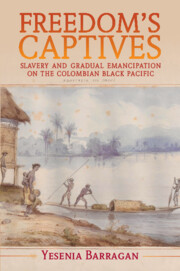Book contents
- Freedom’s Captives
- Afro-Latin America
- Freedom’s Captives
- Copyright page
- Dedication
- Epigraph
- Contents
- Figures
- Tables
- Acknowledgments
- Introduction
- Part I The Social Universe of the Colombian Black Pacific
- 1 Black Freedom and the Aquatic Lowlands
- 2 Slavery and the Urban Pacific Frontier
- Part II The Time of Gradual Emancipation Rule
- Part III Final Abolition and the Afterlife of Gradual Emancipation
- Epilogue
- Bibliography
- Index
2 - Slavery and the Urban Pacific Frontier
from Part I - The Social Universe of the Colombian Black Pacific
Published online by Cambridge University Press: 18 June 2021
- Freedom’s Captives
- Afro-Latin America
- Freedom’s Captives
- Copyright page
- Dedication
- Epigraph
- Contents
- Figures
- Tables
- Acknowledgments
- Introduction
- Part I The Social Universe of the Colombian Black Pacific
- 1 Black Freedom and the Aquatic Lowlands
- 2 Slavery and the Urban Pacific Frontier
- Part II The Time of Gradual Emancipation Rule
- Part III Final Abolition and the Afterlife of Gradual Emancipation
- Epilogue
- Bibliography
- Index
Summary
Chapter 2 leaves the rural rainforests of the northern Pacific lowlands for its two small urban frontier towns: Nóvita—the capital of Chocó before independence—and Quibdó—the capital of Chocó afterward—where the majority population of white slaveholders and mineowners lived alongside the entrepreneurial merchants from Jamaica, France, and Italy who began to settle in the Pacific lowlands after independence. Based on tax records, wills, travelogues, and other archival sources, this chapter offers a door-to-door geography of Quibdó after the Wars of Independence and explores the small-scale slaveholding central to its households. Despite slavery’s slow destruction under gradual emancipation rule, the local trade in slaves and Free Womb children paradoxically remained as active as ever in Chocó well into the 1830s and 1840s.
Keywords
- Type
- Chapter
- Information
- Freedom's CaptivesSlavery and Gradual Emancipation on the Colombian Black Pacific, pp. 73 - 104Publisher: Cambridge University PressPrint publication year: 2021

